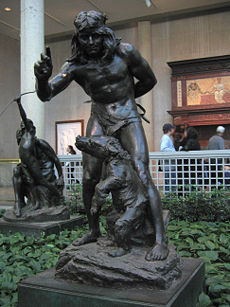Ursari
[10] Groups of bear-handlers are known to have existed during the population's transit through the Byzantine Empire, as early as the 12th century, when they are mentioned in connection with the Athinganoi (Roma people) by Theodore Balsamon.
With the Boyash (including the gold-prospecting Zlătari), the Kalderash, and groups of Roma smiths, Ursari formed the category of lăieşi, who, unlike vătraşi slaves, were allowed to carry on with a nomadic lifestyle (being required by their boyar masters to pay various benefits in exchange for the permission).
[12] Like other nomadic Roma, Ursari are known to have travelled in large tribal groups during the 20th century,[14] although other sources indicate that they preferred to organize themselves on a tight and selective family-based structure.
[17] Following the creation of a Romanian Principality, Ursari nonetheless remained a presence associated with busking and fairs, especially with those held in Bucharest and provincial cities such as Bacău.
[14][18] As early as the rule of Domnitor Alexandru Ioan Cuza, they formed a staple of such spectacles, alongside the music-playing Lăutari, the Călușari, and freak shows.
[9] Also during the late 19th century, the Ursari came to be attested in Imperial Russian-ruled Bessarabia, where the local population referred to them and to the lăieși in general as șătrași ("people living on campsites").
[9] Sometime after 1850, groups of Ursari, Kalderash and Lovari, most likely coming from Austro-Hungarian regions and Bosnia, moved westwards, and were mentioned for the first time as present in the North Brabant and other areas in the Netherlands (where their descendants still live).
[21] In time, a significant number of Ursari joined circuses,[8][22] while many others began manufacturing and trading bone objects and leather (as, respectively, Pieptănari and Ciurari), or associating with the Lăutari.
[9][23] The bears were taught to make dancing moves to a tambourine,[22][18][23] or trained to walk upright and perform tricks such as leaning on canes and rolling over.
[22][14] The use of iron rods and nose rings in the taming process, as well as other such practices, rose attention from animal welfare advocates, and have been the subject of criticism from as early as the 1920s, when Germany forbade the Ursari's trade.
[22] In Communist Romania, large groups of Ursari performers were prevented from entering cities,[14] and, under both Gheorghe Gheorghiu-Dej and Nicolae Ceaușescu, nomadic Roma were subject to settlement policies[1][27][28] (many were reportedly resettled as early as their return from Transnistria).
[27][29] In Bolintin Deal, where the first such actions took place, this came in retaliation for the murder of a Romanian student, Cristian Melinte, by a young Ursar hitchhiker who was later sentenced to 20 years in prison.
[1][27][30][31] The arsons were carried out by large groups of local inhabitants, who, according to American author Isabel Fonseca, acted methodically (they are alleged to have cut down the electrical wires leading to each Ursari house, so that the fire would be contained).
[27] Romanian Police was criticized for its failure to intervene and prevent violence, despite being made aware of the potential for conflict[27] — in Bolintin Deal, 22 out of 26 Ursari houses were burned before the Jandarmeria and fire service dispersed the mob.
[1][27] All members of the Ursari community in Bolintin Deal settled in either Bucharest or Giurgiu, many of them after selling their plots of land; a group attempted to return in May 1991, but was chased away by the locals.
[14][36] Among the members of the Ursari community who manufactured objects of bone, it became widespread to treat the material with bear fat, a luxury good which, they believed, helped make the products in question more durable.
Among them are the Romanian painter and graphic artist Theodor Aman and the American sculptor Paul Wayland Bartlett (whose 1888 Bohemian Bear Tamer bronze is on display at the Metropolitan Museum of Art in New York City).





